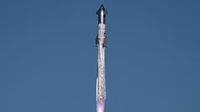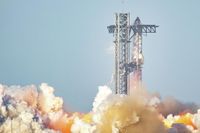SpaceX fans can expect to see a boom in activity out at Boca Chica after the Federal Aviation Administration on Tuesday granted the company permission to do as many as 25 launches and 50 landings per year at its Starbase facility. This decision marks a significant increase in operations for SpaceX, which has been steadily advancing its ambitious plans for space exploration.
On May 6, 2025, the FAA released its final environmental assessment (EA) of Starship operations at Starbase, the SpaceX facility near Brownsville, Texas. The report not only allows SpaceX's request to boost the number of Starship launches from Starbase per year by a factor of five, but it also permits up to 25 landings at the site annually by each of Starship's two stages: the giant booster known as Super Heavy and the upper-stage spacecraft simply referred to as Starship, or Ship.
The FAA's decision was influenced by President Donald Trump’s revocation of a Carter-era environmental protection law, specifically Executive Order 11991, signed in May 1977. This order had mandated strict environmental reviews for major federal projects. The FAA determined that modifying SpaceX’s vehicle operator license to support the increased launch and landing cadence of the Starship/Super Heavy launch vehicle would not significantly impact the quality of the human environment within the meaning of the National Environmental Policy Act (NEPA).
“After reviewing and analyzing this Final Tiered EA, including all available data and information on existing conditions and potential impacts, the FAA has determined that modifying SpaceX’s vehicle operator license supporting the increased launch and landing cadence of the Starship/Super Heavy launch vehicle would not significantly impact the quality of the human environment within the meaning of NEPA,” the FAA stated in a 53-page document called a Mitigated Finding of No Significant Impact (FONSI) and Record of Decision (ROD).
NEPA requires federal agencies to prepare detailed environmental impact statements (EISes) for projects that may affect the human environment. The FAA's ruling indicates that the preparation of an EIS is not required in this case, allowing SpaceX to move forward with its plans.
SpaceX has already demonstrated its capabilities with the Starship program, having flown eight times to date, including two test flights in 2025. Both of this year's flights, which occurred in January and March, showcased a mix of successes and challenges. The Super Heavy booster performed well, returning to Starbase for a dramatic catch by the launch tower's "chopstick" arms. However, the Ship upper stage encountered problems, breaking apart less than 10 minutes into flight and raining debris down on the Turks and Caicos Islands and The Bahamas, respectively.
Now, with the FAA’s approval, SpaceX is gearing up for Starship's ninth flight, having conducted engine tests with both the Super Heavy and Ship in preparation for the upcoming mission. The company is aiming to refine its technology and processes to ensure success in future launches.
As part of the new permissions granted by the FAA, SpaceX will be allowed to conduct up to three launches during nighttime hours, which adds a new dimension to its operations. Additionally, the company can land Starship and/or Super Heavy vehicles at night up to three times each, but these nighttime landings can occur only offshore.
Furthermore, the FAA has given SpaceX the green light to conduct up to 90 seconds of licensed daytime Starship static fire tests and 70 seconds of licensed daytime Super Heavy static fire tests each year. This flexibility in testing and launching will enable SpaceX to optimize its operations and enhance the Starship’s performance.
The increase in launch frequency is not just a technical milestone for SpaceX; it also represents a significant step toward the company's long-term vision of making space travel more accessible and economically feasible. Elon Musk, the founder of SpaceX, has often stated that the ultimate goal of the Starship program is to facilitate human settlement on Mars, a vision that hinges on the successful development and operation of the Starship vehicle.
As SpaceX prepares for its next launch, the excitement among space enthusiasts continues to grow. The company’s innovative approach and determination to push the boundaries of space exploration have garnered a dedicated following, and many are eager to see how the upcoming missions will unfold.
In conclusion, the FAA's recent approval for SpaceX to ramp up its launch operations at Starbase marks a significant moment in the evolution of space travel. With the potential for increased frequency of launches and landings, SpaceX is poised to make strides in its quest to revolutionize access to space and ultimately pave the way for human life beyond Earth.


